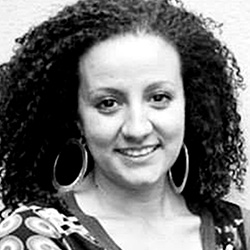Marcella del Signore, New York Institute of Technology – Collaboration and Digital Spaces
 On New York Institute of Technology Week: Our interactions with spaces have expanded beyond the physical.
On New York Institute of Technology Week: Our interactions with spaces have expanded beyond the physical.
Marcella del Signore, associate professor of architecture, examines how the digital sphere can change our relationship with a space.
Marcella Del Signore is an architect and the principal of X-Topia, a design-research practice that explores the intersection of architecture and urbanism with digital practices. Her work concentrates on the relationship between architecture and urbanism by leveraging emerging technologies to imagine scenarios for the future of environments and cities. Her background in architecture and urban design has led her to explore and implement projects that investigate the relationships between contemporary architectural practice and the public/social/cultural scale in dialogue with technologically mediated systems. In her practice, she has been focusing on inter-scalar approaches to design, from small scale interventions, installations, and prototypes to buildings to the urban scale. This approach has led her to work across scales and protocols from material, morphological, spatial, and performative dimensions to the larger interlacement of spatial and urban systems. She holds a Master in Architecture from La Sapienza University in Rome and a Master of Science in Advanced Architectural Design from Columbia University in New York.
Del Signore is the author of Urban Machines: Public Space in a Digital Culture (ListLab, 2018, with Gernot Riether), which explores how information and communication technologies have radically changed the way we inhabit and operate in the urban space. She is the the co-editor of Recalibration: On Imprecision and Infidelity (with Phillip Anzalone and Andrew J. Wit) paper and project proceedings, published during the 2018 ACADIA (Association for Computer Aided Design in Architecture) Conference, where she served as Technical Co-Chair and part of the ACADIA Board of Directors from 2016-18.
She has taught and collaborated with academic institutions in Europe and the U.S. including Tulane University, Barnard College at Columbia University, the Architectural Association, IaaC(Institute of Advanced Architecture of Catalonia), University of Waterloo, LSU School of Architecture, IN/ARCH (National Italian Institute of Architecture and University of Trento). At Tulane University, she taught in the School of Architecture from 2008 to 2017, served as the Director of the Rome Study Abroad Program, and in 2016, was appointed the Kylene and Brad Beers SE Professor at the Taylor Center for Social Innovation and Design Thinking.
Del Signore has worked nationally and internationally through an extended network of partners, institutions, and sponsors that have supported her work, receiving several awards and recognitions including the “Young Italian Talent” in architecture and design in 2010 by the Italian Ministry, the “Urban Urge Award” grant in 2014 (with Mona El Khafif), and the “American Architectural Prize” at the Cooper Hewitt Smithsonian Design Museum in the “other interior design” category in 2017 (with OSW). She has developed projects and research supported and promoted by the NEA(National Endowment for the Arts), Gray Area Foundation for the Arts, Zero1 Art and Technology Biennal, European Union, The Arts Council of New Orleans, Northern Spark Minneapolis, Emerging Artist Network, Fast Company– Design + Innovation, the BMW Guggenheim Lab, Milan Design Week, and the AIA New Orleans among others.
She is a licensed architect and has practiced in Rome, New Orleans, and New York. In New York, she worked at Eisenman Architects and Richard Meier & Partners. In 2018, she co-curated with Nancy Diniz and Frank Melendez at the ‘DATA & MATTER’ Exhibition at the European Cultural Center during the 2018 Architecture Venice Biennale. She has lectured, published, and exhibited widely.
Collaboration and Digital Spaces
Before radio or TV, people gathered in public spaces to remain informed and market their goods. Today we no longer inhabit our cities in just the physical realm, but in the digital realm as well.
Now mobile devices connect us with our urban environments daily. What route avoids traffic? Where’s the best restaurant nearby? No need to look further than your cell phone to find these answers.
But technology has also made us avid collaborators. We not only occupy the virtual realm to seek information, we also play an active role in providing it. For instance, wiki websites now allow us to share knowledge widely in the digital space without the challenge of authenticating authority on a given topic. These forums have given us the power to inform, influence, and build the virtual communities we inhabit.
As devices allow for more efficiency and collaboration, we may come to expect the same synergy from the physical places we occupy. Our needs may demand more participatory interfaces in place of traditional public spaces. These areas may become “wiki-spaces,” interactive environments where occupants are not just observers but active participants.
The flexibility afforded by mobile technology has changed our relationships with our cities. As more digital information becomes available, we will surely discover new ways to navigate and utilize urban spaces. The practice of urban design will continue to support integrated models that take into account not only physical space but digital systems.


